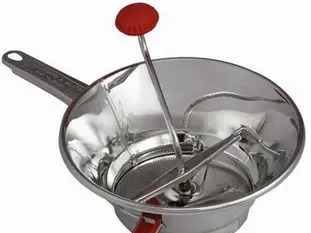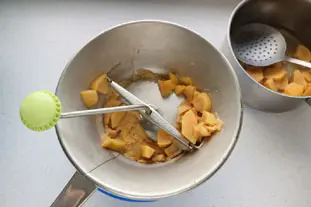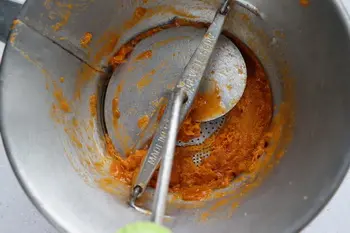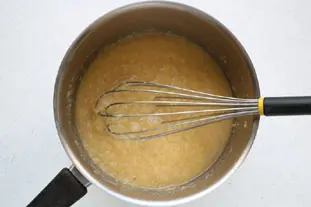This site uses only a few technical cookies necessary for its operation. By continuing to browse, you accept their use.
To find out more...
To find out more...
In Praise of the Vegetable Mill

When a recipe or preparation calls for something solid to be pureed, as in a soup for example, the natural reflex is to take out the blender and plunge it into the saucepan.
This works very well in most cases, but there are times when you'd like to puree something and at the same time remove the hard parts or skins from the preparation.
Another reflex in this case is to pass the whole preparation through a sieve or a very fine strainer, which also works well, but can be a bit tedious.
But there's a very old utensil, still in use today, which allows you to do both operations at once: it purées and retains the hard parts.
This works very well in most cases, but there are times when you'd like to puree something and at the same time remove the hard parts or skins from the preparation.
Another reflex in this case is to pass the whole preparation through a sieve or a very fine strainer, which also works well, but can be a bit tedious.
But there's a very old utensil, still in use today, which allows you to do both operations at once: it purées and retains the hard parts.
11 K 5/5 (4 reviews)
Keywords for this post:MillVegetablesUtensilUseClassicMaterialPuréeCoulisLast modified on: July 12th 2023
In Praise of the Vegetable Mill
The food mill is an entirely manual utensil that is simple, highly efficient and inexpensive.
It's a flared metal or plastic container, with a grid of more or less fine holes lining the bottom.
A plate, which turns with a simple crank, forces the poured preparation through the grid.
Place the mill on a container (saucepan, salad bowl, etc.) - it has 3 feet for this purpose - pour the preparation into it and turn the crank, "grinding" until all the preparation has passed through the grid, turning the crank in the other direction from time to time to clear the grid.
It's called a vegetable mill, because that's its original use, but it can be used with any fairly tender, often cooked, preparation that needs to be turned into a kind of purée (some even call it a "potato masher") or coulis, vegetables and soups of course, but also fruit, fruit purée or any other food tender enough for that.
It's ideal for this job, because it works without forcing or pulverizing like a blender would. As a result, mashed potatoes made in a blender quickly become sticky, which is never the case with a food mill.
And above all, of course, it separates.
Making fruit jelly, blackcurrant jelly for example, becomes much easier if you put the fruit through the food mill before cooking it.
My grandmother and mother had one, as did I, and I've converted my sons to them.
Over time, though, the principle hasn't changed one iota, the material is a little different: tin-plated iron in the olden days, stainless steel or plastic nowadays, but there's still no need to connect it to a power source, apart from elbow grease of course.
To sum up: the food mill is the essential manual tool for pureeing and separating the hard parts of cooked or fairly soft foods.
How does it work?

It's a flared metal or plastic container, with a grid of more or less fine holes lining the bottom.
A plate, which turns with a simple crank, forces the poured preparation through the grid.
Place the mill on a container (saucepan, salad bowl, etc.) - it has 3 feet for this purpose - pour the preparation into it and turn the crank, "grinding" until all the preparation has passed through the grid, turning the crank in the other direction from time to time to clear the grid.

At the end, all that's left to do is to discard (in the composter if possible) the hard parts remaining on the grid, and start again.
It's super-simple and highly effective.

Vegetables only?
It's called a vegetable mill, because that's its original use, but it can be used with any fairly tender, often cooked, preparation that needs to be turned into a kind of purée (some even call it a "potato masher") or coulis, vegetables and soups of course, but also fruit, fruit purée or any other food tender enough for that.
It's ideal for this job, because it works without forcing or pulverizing like a blender would. As a result, mashed potatoes made in a blender quickly become sticky, which is never the case with a food mill.
And above all, of course, it separates.
Making fruit jelly, blackcurrant jelly for example, becomes much easier if you put the fruit through the food mill before cooking it.
An old-fashioned utensil
My grandmother and mother had one, as did I, and I've converted my sons to them.
Over time, though, the principle hasn't changed one iota, the material is a little different: tin-plated iron in the olden days, stainless steel or plastic nowadays, but there's still no need to connect it to a power source, apart from elbow grease of course.
To sum up: the food mill is the essential manual tool for pureeing and separating the hard parts of cooked or fairly soft foods.
Lasts posts
Butter vs. grease
We often read in a recipe where a pastry is put into a mould that, just before pouring, the mould should be buttered or greased. But what's the difference between these 2 terms?December 1st 20259555
Getting out of the fridge early
Very often when you're cooking, you need to take food or preparations out of the fridge, to use them in the recipe in progress. There's nothing tricky about this: you just take them out of the fridge and use them, usually immediately, in the recipe. But is this really a good method?November 24th 20251,0865
Who's making the croissants?
When you look at a bakery from the outside, you naturally think that in the bakery, the bakers make the bread, and in the laboratory, the pastry chefs make the cakes. It's very often like that, with each of these professions having quite different ways of working, but sometimes there's also one...November 23th 2025983
Oven height
When we put a dish or cake in the oven, we naturally tend to put it on the middle shelf, and that's what we usually do. But in some cases, this position and height can be a little tricky, so let's find out why.October 8th 20252,6835
The importance of sieving
In recipes that use a fine powder (flour, powdered sugar, etc.), you'll often see the advice to sift before using it. To sift is to pass the powder in question through a sieve (a very fine strainer) before incorporating it into your recipe. It's often advice, but is it really useful?September 3rd 20257,5073
Other pages you may also like
Tranché, dissociated, failed, in short... missed!
When preparing a sauce or a cream, there's always a (small) risk that the creamy preparation you're working on will suddenly separate into two parts of different textures: a liquid part, for example, and a more or less solid part, or even become lumpy. It's terribly frustrating, but we'll see...June 19th 202313 K5
Candied fruits: don't get ripped off
Do you like candied fruit? You might like to nibble a handful or add it to a recipe, like a classic fruit cake or delicious Italian specialities like panettone or sicilian epiphany pie.June 21th 201767 K 24.2
Drawing a pattern in pastry
Often in the kitchen, in pastry-making, or in baking, we need to trace a pattern on a pastry. It's just a question of aesthetics but it has its effect after baking on a galette, pithiviers, pâté en croute (terrine in a pie crust), etc.May 23th 201935 K4.1
Cleaning endives
If you buy your endives elsewhere than in supermarkets, and in this case the best is of course from a market gardener, he or she is the one who planted and harvested them, in this case you will have endives full of earth or sand, depending on where they were grown, which is normal and reassuring, we...March 24th 202026 K4.6
Kitchen ovens
You certainly have one in your kitchen, an oven, the essential tool for all kinds of cooking, whether in the kitchen of course, but also in pastry, bakery, pizza, and many others. Here is some information on its structure and operation.May 16th 202034 K4.4
Post a comment or question
Follow this page
If you are interested in this page, you can "follow" it, by entering your email address here. You will then receive a notification immediately each time the page is modified or a new comment is added. Please note that you will need to confirm this following.
Note: We'll never share your e-mail address with anyone else.
Alternatively: you can subscribe to the mailing list of cooling-ez.com , you will receive a e-mail for each new recipe published on the site.









